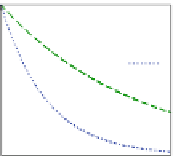Biomedical Engineering Reference
In-Depth Information
Fig. 9.22
The decay of the
exciton occupation without
carrier-phonon interaction for
three different initial states at
constant temperature
T
1
|+〉
|
y
+
〉
|
y
−
〉
=
4K,
D
=
6nm,and
θ
=
−
π
/
6[
52
]
0
0
1
2
time [ns]
9.5.1
The Role of Phonons in the Collective Luminescence
from Double Quantum Dots
In this section, we present and discuss the results of numerical simulations of the
spontaneous emission from DQD systems under the influence of phonons [
52
]. We
study theoretically the kinetics of radiative recombination of excitons confined in a
system consisting of two coupled self-assembled QDs.
As discussed in Sect.
9.4.1
, the coupling between the dots leads to the formation
of two delocalized eigenstates
|
Ψ
±
with different decay rates. We assume negative
coupling (
V
0); hence, the mixing angle of the single-exciton states (defined in
Sect.
9.4.1
) is also negative,
≤
θ
≤
0. In this case, the state
|
Ψ
+
is darker and decays
slower while the state
is brighter and decays faster. Figure
9.22
presents the
evolution of the exciton occupation in the DQD system without carrier-phonon
coupling (in this case, the resulting decay depends only on the mixing angle
|
Ψ
−
).
Two limiting cases, the dark and bright state, are shown with the green dashed
and blue dotted lines,
re
spectively. For a general initial state, including the state
|
+
=(
|
θ
)
/
√
2 (red solid line), the decay is not simply exponential. Note
that this state is particularly interesting because it corresponds to optical excitation
by a laser pulse.
When the carrier-phonon interaction is taken into account, one observes changes
of the recombination kinetics. Typically, carrier-phonon interaction leads to the
redistribution of the occupations on a time scale much shorter than the exciton life
time, hence the dependence on the initial state observed in Fig.
9.22
is suppressed.
As shown in the left panel of Fig.
9.24
, for strong phonon coupling, corresponding
to the first maximum of the spectral density (Fig.
9.23
), the radiative decay is nearly
insensitive to the initial state. When the energy splitting corresponds to the first
minimum of the spectral density, the situation is still very similar in spite of a much
weaker coupling, as shown in the right panel of Fig.
9.24
.
An important effect of phonon interaction in radiative recombination is a strong
temperature dependence of the emission process. This is shown in Fig.
9.25
(left
panel) for the initial optically generated state
01
+
|
10
at various temperatures and
system parameters. In this case, phonon-induced relaxation is efficient as the
energy splitting 2
|
+
corresponds to the first maximum of the spectral density.
With increasing temperature the occupation of the dark state increases at the
E






































